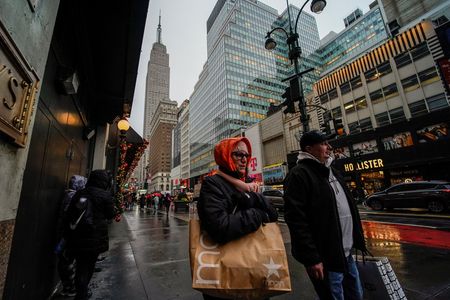
WASHINGTON (Reuters) – U.S. consumer spending barely rose in November, while inflation cooled further, but not enough to discourage the Federal Reserve from driving interest rates to higher levels next year.
Consumer spending, which accounts for more than two-thirds of U.S. economic activity, edged up 0.1%, the Commerce Department said on Friday. Data for October was revised up to show spending surging 0.9% instead of 0.8% as previously reported.
Economists polled by Reuters had forecast consumer spending rising 0.2%. Some of the moderation in spending last month reflected a shift demand from goods to services.
Slowing price increases for some goods also lowered the dollar amount of consumer spending.
Nevertheless, consumer spending is on track to provide another lift to economic growth this quarter, after teaming up with exports to boost gross domestic product in the third quarter. The economy grew at a 3.2% annualized rate last quarter after contracting in the first half of the year.
Growth estimates for the fourth quarter are as high as a 2.7% pace. Consumer spending is being driven by solid wage gains, thanks to a tight labor market, as well as savings accumulated during first year of the COVID-19 pandemic.
The U.S. central bank is trying to slow demand for everything from housing to labor as it fights to bring inflation back to its 2% target.
The Fed last week hiked its policy rate by 50 basis points to a 4.25%-4.50% range, the highest since late 2007. Fed officials expect the rate to rise to between 5.00% and 5.25% next year, a level that could be sustained for a while.
Higher borrowing costs, fast depleting savings and diminishing household wealth could stifle consumer spending, and tip the economy into recession next year.
The personal consumption expenditures (PCE) price index rose 0.1% last month after climbing 0.4% in October. In the 12 months through November, the PCE price index increased 5.5% after advancing 6.1% in October.
Excluding the volatile food and energy components, the PCE price index gained 0.2% after increasing 0.3% in October. The so-called core PCE price index rose 4.7% on a year-on-year basis in November after increasing 5.0% in October.
The Fed tracks the PCE price indexes for monetary policy. Other inflation measures have also shown signs of slowing.
Consumer prices rose less than expected for a second straight month in November. Consumers’ one-year inflation expectations also moderated in December, strengthening views that price pressures peaked several months ago.
(Reporting by Lucia Mutikani; Editing by Dan Burns)

